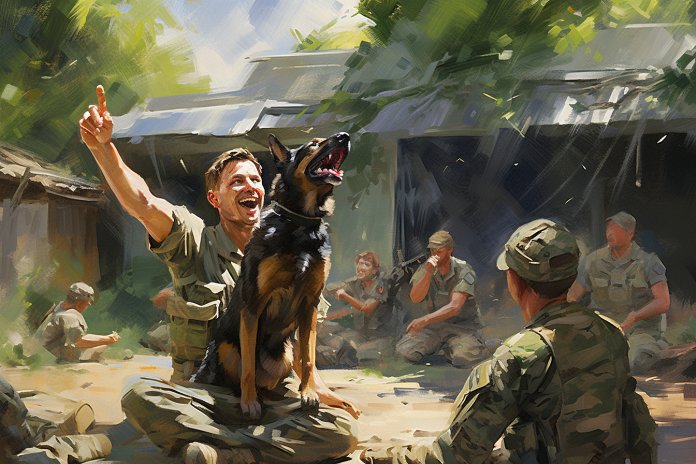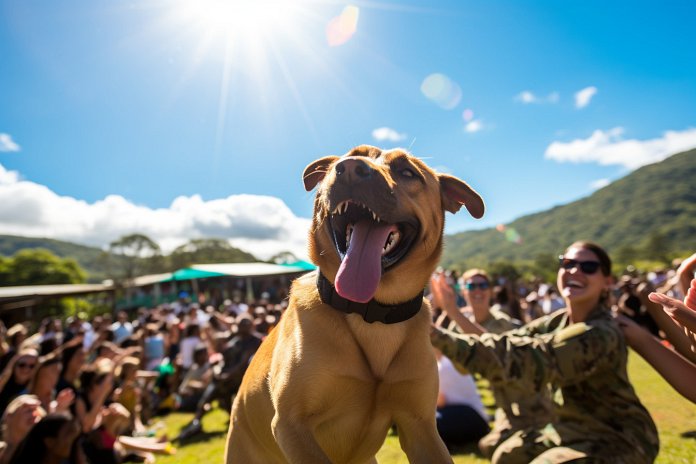
The military life brings both opportunities and challenges for families. While it offers the chance to live in new places, meet new people, and experience different cultures, it also involves frequent moves and separations. Some may believe that getting a dog can provide security and comfort to family members during the adjustments that come with military life.
Signs a Dog Will Do Well on a Military Base:
When living in any community, especially a military setting, it’s important to have a dog with a healthy and sociable temperament. Just like with people, you can form an impression about a dog’s friendliness based on certain signs. It’s crucial to learn these signs for the safety of both you and your family. Teach your children how to approach dogs and recognize signs of sociability.
To determine if a dog is calm and happy, observe their eyes, mouth, ears, tail, and body posture. A social dog will have relaxed eyes and eyelids, an open mouth with a loose tongue, and relaxed ears. Their body posture will appear relaxed, and their tail may wag to the right and down. They may also invite you to play with a play bow.
On the other hand, signs of aggression in a dog include narrow and focused eyes, an aroused and alert pose, pinned back ears, exposed teeth and curled lips, and barking or growling.
Restrictions for Dogs on Military Bases:
The military has placed restrictions on certain dog breeds that are believed to be potentially aggressive. These breeds include Pit Bulls, Rottweilers, Doberman Pinschers, Chow Chows, and Wolf Hybrids. However, if a family owned the dog before the restriction went into effect, they should be allowed to keep the pet.
The Science of Dogs Living on a Military Base:
Military housing allows up to two dogs that are not on the restricted list. You can also have up to two cats, caged animals, and aquarium pets. However, animals like goats, pot-bellied pigs, hedgehogs, skunks, rats, snakes, spiders, and raccoons are not permitted. It’s important not to lie about your pets, as it is considered an offense. Different states may have specific requirements for pet vaccinations and health certificates when moving.
Teaching Others to Approach Your Dog:
Regardless of breed, it’s crucial to teach children how to approach dogs safely. Many dog bites occur when children provoke dogs unknowingly. Teach children to walk calmly around dogs, stay away if the dog doesn’t appear calm, ask permission before approaching or touching a dog, move slowly and face the dog, hold their hand out with the palm facing up, avoid petting the dog on top of the head, and keep their face away from the dog. Always supervise animals and children, and keep your dog on a leash when outside.
Safety Tips for Keeping Dogs Healthy:
Maintain regular vaccinations, feed a balanced diet, provide regular exercise, license or register your dog according to local regulations, and check rules before traveling. If your family can’t help, there are organizations that can assist with pet care.
“A dog brings security and comfort to military families, but it’s important to know the restrictions and signs of a good fit before getting one.”

Tips & Things to Know
1️⃣ Before getting a dog for your family in the military, make sure to review the restrictions on dog breeds allowed on military bases. This is important for housing and pet care options.
2️⃣ When looking for a dog that will do well on a military base, look for signs of a sociable and friendly temperament. Pay attention to the dog’s eyes, mouth, ears, tail, and body posture to determine if the animal is calm and happy.
3️⃣ Teach children how to approach dogs safely to prevent provoking bites. Teach them to walk and move calmly around dogs, to ask the owner before approaching or touching the dog, and to pet the dog in a non-threatening way by avoiding the head and keeping their face away from the dog.
Frequently Asked Questions, Answered ✅
1. What are some signs to watch for to determine if a dog will do well on a military base?
– Signs include relaxed eyes, open mouth with tongue hanging loose, relaxed ears, and a calm and relaxed physical posture.
2. What are some signs that indicate a dog may be aggressive?
– Signs include narrowed eyes, appearing alert and aroused with a forward pose, exposing teeth and curling the lip, and growling or barking.
3. What dog breeds are restricted on military bases?
– Pit Bulls (American Staffordshire Terriers and Staffordshire Bull Terriers), Rottweilers, Doberman Pinschers, Chow Chows, and Wolf Hybrids.
4. What are some safety tips for keeping dogs healthy on a military base?
– Maintain vaccinations routine, feed a balanced diet, make arrangements for regular exercise, license or register the dog according to local regulations, and check the rules before traveling.
5. Are there organizations that can help with the care of a pet while a military member is deployed?
– Yes, organizations such as Dogs on Deployment and Guardian Angels for Soldier’s Pet can provide care for military pets while their owners are away.